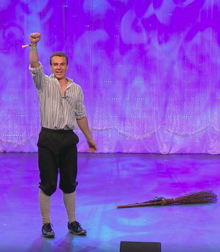| Welsh stepdance | |
|---|---|
 Welsh clog dancer on stage at the National Eisteddfod in Bodedern, 2017. | |
| Medium | Dance |
| Originating culture | Welsh |
| Originating era | 18th century |
| Part of a series on the |
| Culture of Wales |
|---|
 |
| People |
| Art |

The Welsh stepdance (Welsh: Dawns stepio) or Welsh clog dance (Welsh: Clocsio) is a traditional Welsh form of dance involving clog shoes and percussive movement of the feet and athletic movements. It is typically done to Welsh traditional music and wearing traditional Welsh costume, but not always.
The Welsh stepdance is an unbroken tradition that was typically performed by slate quarry workmen and farmers. Dancers would often compete with each other to prove who had the most impressive dancing, stamina and athleticism. Welsh clog dancing also includes "tricks" which makes it unique compared to other forms of step dancing such as Irish dancing, Scottish dancing and English clog dancing. These tricks can include, but are not limited to; snuffing out a candle flame using the wooden soles of the shoes, toby stepping (kicking legs out in a squat position similarly to Cossack dancing) and high leaps into the air such as straddle jumping.[1]
Clogging does not simply involve dancing whilst wearing clogs. Clogging involves producing a variety of stronger or lighter sounds and a mixture of rhythms using both feet, which showcases the stepping dexterity. A talented clogger is able to make a variety of sounds by utilising different regions of the clog which include the toe, heel and sides of the clog against each other or other objects. Clogging can be performed on wood and slate and can be accompanied or unaccompanied.[2]
- ^ "BBC Wales - Music - Folk and traditional - Clog dancing in Wales". www.bbc.co.uk. Retrieved 2022-02-06.
- ^ "Clocsio". www.welshfolkdance.org.uk. Retrieved 2022-02-06.
